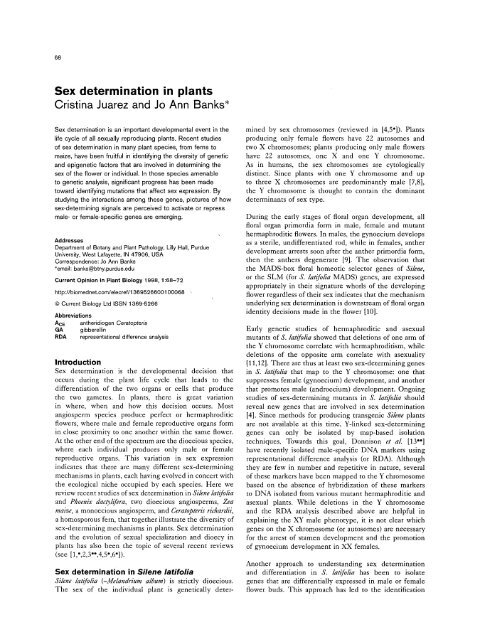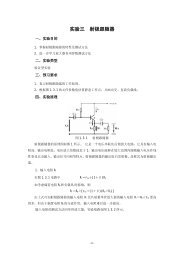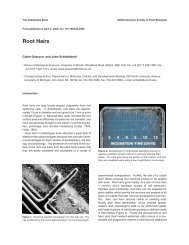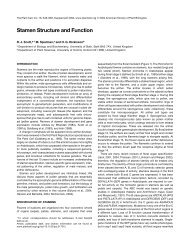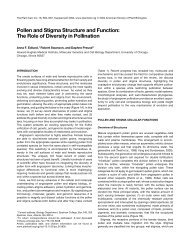Sex determination in plants Cristina Juarez and Jo Ann Banks*
Sex determination in plants Cristina Juarez and Jo Ann Banks*
Sex determination in plants Cristina Juarez and Jo Ann Banks*
You also want an ePaper? Increase the reach of your titles
YUMPU automatically turns print PDFs into web optimized ePapers that Google loves.
68<strong>Sex</strong> <strong>determ<strong>in</strong>ation</strong> <strong>in</strong> <strong>plants</strong>Crist<strong>in</strong>a <strong>Juarez</strong> <strong>and</strong> <strong>Jo</strong> <strong>Ann</strong> <strong>Banks*</strong><strong>Sex</strong> <strong>determ<strong>in</strong>ation</strong> is an important developmental event <strong>in</strong> thelife cycle of all sexually reproduc<strong>in</strong>g <strong>plants</strong>. Recent studiesof sex <strong>determ<strong>in</strong>ation</strong> <strong>in</strong> many plant species, from ferns tomaize, have been fruitful <strong>in</strong> identify<strong>in</strong>g the diversity of genetic<strong>and</strong> epigenetic factors that are <strong>in</strong>volved <strong>in</strong> determ<strong>in</strong><strong>in</strong>g thesex of the flower or <strong>in</strong>dividual. In those species amenableto genetic analysis, significant progress has been madetoward identify<strong>in</strong>g mutations that affect sex expression. Bystudy<strong>in</strong>g the <strong>in</strong>teractions among these genes, pictures of howsex-determ<strong>in</strong><strong>in</strong>g signals are perceived to activate or repressmale- or female-specific genes are emerg<strong>in</strong>g.AddressesDepartment of Botany <strong>and</strong> Plant Pathology, Lilly Hall, PurdueUniversity, West Lafayette, IN 47906, USACorrespondence: <strong>Jo</strong> <strong>Ann</strong> <strong>Banks*</strong>email: ban ks@btny.purdue.eduCurrent Op<strong>in</strong>ion <strong>in</strong> Plant Biology 1998, 1:68-72http://biomednet.com/elecref/1369526600100068 .© Current Biology Ltd ISSN 1369-6266AbbreviationsACE antheridiogen CeratopterisGA gibberell<strong>in</strong>RDA representational difference analysisIntroduction<strong>Sex</strong> <strong>determ<strong>in</strong>ation</strong> is the developmental decision thatoccurs dur<strong>in</strong>g the plant life cycle that leads to thedifferentiation of the two organs or cells that producethe two gametes. In <strong>plants</strong>, there is great variation<strong>in</strong> where, when <strong>and</strong> how this decision occurs. Mostangiosperm species produce perfect or hermaphroditicflowers, where male <strong>and</strong> female reproductive organs form<strong>in</strong> close proximity to one another with<strong>in</strong> the same flower.At the other end of the spectrum are the dioecious species,where each <strong>in</strong>dividual produces only male or femalereproductive organs. This variation <strong>in</strong> sex expression<strong>in</strong>dicates that there are many different sex-determ<strong>in</strong><strong>in</strong>gmechanisms <strong>in</strong> <strong>plants</strong>, each hav<strong>in</strong>g evolved <strong>in</strong> concert withthe ecological niche occupied by each species. Here wereview recent studies of sex <strong>determ<strong>in</strong>ation</strong> <strong>in</strong> Silene latifolia<strong>and</strong> Phoenix dactylifera, two dioecious angiosperms, Zeamaize, a monoecious angiosperm, <strong>and</strong> Ceratopteris richardii,a homosporous fern, that together illustrate the diversity ofsex-determ<strong>in</strong><strong>in</strong>g mechanisms <strong>in</strong> <strong>plants</strong>. <strong>Sex</strong> <strong>determ<strong>in</strong>ation</strong><strong>and</strong> the evolution of sexual specialization <strong>and</strong> dioecy <strong>in</strong><strong>plants</strong> has also been the topic of several recent reviews(see [1,',2,3"°,4,5°,6"]).<strong>Sex</strong> <strong>determ<strong>in</strong>ation</strong> <strong>in</strong> Silene latifoliaSilene latifolia (=Mel<strong>and</strong>rium album) is strictly dioecious.The sex of the <strong>in</strong>dividual plant is genetically deter-m<strong>in</strong>ed by sex chromosomes (reviewed <strong>in</strong> [4,5°]). Plantsproduc<strong>in</strong>g only female flowers have 22 autosomes <strong>and</strong>two X chromosomes; <strong>plants</strong> produc<strong>in</strong>g only male flowershave 22 autosomes, one X <strong>and</strong> one Y chromosome.As <strong>in</strong> humans, the sex chromosomes are cytologicallydist<strong>in</strong>ct. S<strong>in</strong>ce <strong>plants</strong> with one Y chromosome <strong>and</strong> upto three X chromosomes are predom<strong>in</strong>antly male [7,8],the Y chromosome is thought to conta<strong>in</strong> the dom<strong>in</strong>antdeterm<strong>in</strong>ants of sex type.Dur<strong>in</strong>g the early stages of floral organ development, allfloral organ primordia form <strong>in</strong> male, female <strong>and</strong> mutanthermaphroditic flowers. In males, the gynoecium developsas a sterile, undifferentiated rod, while <strong>in</strong> females, antherdevelopment arrests soon after the anther primordia form,then the anthers degenerate [9]. The observation thatthe MADS-box floral homeotic selector genes of Silene,or the SLM (for S. latifolia MADS) genes, are expressedappropriately <strong>in</strong> their signature whorls of the develop<strong>in</strong>gflower regardless of their sex <strong>in</strong>dicates that the mechanismunderly<strong>in</strong>g sex <strong>determ<strong>in</strong>ation</strong> is downstream of floral organidentity decisions made <strong>in</strong> the flower [10].Early genetic studies of hermaphroditic <strong>and</strong> asexualmutants of S. latifolia showed that deletions of one arm ofthe Y chromosome correlate with hermaphroditism, whiledeletions of the opposite arm correlate with asexuality[11,12]. There are thus at least two sex-determ<strong>in</strong><strong>in</strong>g genes<strong>in</strong> S. latifolia that map to the Y chromosome: one thatsuppresses female (gynoecium) development, <strong>and</strong> anotherthat promotes male (<strong>and</strong>roecium) development. Ongo<strong>in</strong>gstudies of sex-determ<strong>in</strong><strong>in</strong>g mutants <strong>in</strong> S. latifolia shouldreveal new genes that are <strong>in</strong>volved <strong>in</strong> sex <strong>determ<strong>in</strong>ation</strong>[4]. S<strong>in</strong>ce methods for produc<strong>in</strong>g transgenic Silene <strong>plants</strong>are not available at this time, Y-l<strong>in</strong>ked sex-determ<strong>in</strong><strong>in</strong>ggenes can only be isolated by map-based isolationtechniques. Towards this goal, Donnison et al. [13 °°]have recently isolated male-specific DNA markers us<strong>in</strong>grepresentational difference analysis (or RDA). Althoughthey are few <strong>in</strong> number <strong>and</strong> repetitive <strong>in</strong> nature, severalof these markers have been mapped to the Y chromosomebased on the absence of hybridization of these markersto DNA isolated from various mutant hermaphroditic <strong>and</strong>asexual <strong>plants</strong>. While deletions <strong>in</strong> the Y chromosome<strong>and</strong> the RDA analysis described above are helpful <strong>in</strong>expla<strong>in</strong><strong>in</strong>g the XY male phenotype, it is not clear whichgenes on the X chromosome (or autosomes) are necessaryfor the arrest of stamen development <strong>and</strong> the promotionof gynoecium development <strong>in</strong> XX females.Another approach to underst<strong>and</strong><strong>in</strong>g sex <strong>determ<strong>in</strong>ation</strong><strong>and</strong> differentiation <strong>in</strong> S. latifolia has been to isolategenes that are differentially expressed <strong>in</strong> male or femaleflower buds. This approach has led to the identification
<strong>Sex</strong> <strong>determ<strong>in</strong>ation</strong> <strong>in</strong> <strong>plants</strong> <strong>Juarez</strong> <strong>and</strong> Banks 69of several genes, one of which has been characterized<strong>in</strong> detail [14"]. The expression of the Men-9 (maleenhanced) gene is elevated <strong>in</strong> male flowers compared tofemale flowers, as well as <strong>in</strong> pseudohermaphroditic flowerswhich develop on genetically female (XX) <strong>plants</strong> thatare systemically <strong>in</strong>fected with the smut fungus Ustilagoviolacea. Infected female flowers develop stamens whichcarry anthers bear<strong>in</strong>g fungal spores rather than pollen. Insitu hybridizations revealed that Men-9 gene expressiondel<strong>in</strong>eates the boundaries of the third whorl of thedevelop<strong>in</strong>g flower primordia. Dur<strong>in</strong>g the later stages offloral development, a second phase of Men-9 expression isobserved <strong>in</strong> the epidermis <strong>and</strong> endothecium of stamensof male flowers. Although the sequences of Men-9 <strong>and</strong>its <strong>in</strong>ferred prote<strong>in</strong> did not reveal a likely function forthis gene, it may be useful as a molecular marker forunderst<strong>and</strong><strong>in</strong>g what regulates expression of male-specificgenes dur<strong>in</strong>g later stages of flower development."Another approach to study<strong>in</strong>g sex <strong>determ<strong>in</strong>ation</strong> <strong>in</strong> Silenehas been to <strong>in</strong>vestigate the potential role of DNAmethylation <strong>in</strong> this process. The rationale for this approachstems from the observation that one of the two Xchromosomes <strong>in</strong> Silene is hypermethylated [15]. This<strong>in</strong>dicates that there may be a dosage cofiapensationmechanism at work that presumably <strong>in</strong>activates one ofthe two X chromosomes by DNA methylation <strong>in</strong> females,similar to that observed <strong>in</strong> human females. This dosagecompensation mechanism may be responsible for thesuppression of gynoecium development.To test the effects of global demethylation on sexexpression, Janousek et al. [16 °'] treated seeds with5-azacytid<strong>in</strong>e, a drug which demethylates DNA once ithas been <strong>in</strong>corporated <strong>in</strong>to the DNA. This treatment<strong>in</strong>hibited the suppression of gynoecium development, asdemonstrated when 21% of the treated XY male seedsdeveloped as <strong>and</strong>rohermaphrodite <strong>plants</strong> with mosaic<strong>in</strong>florescences consist<strong>in</strong>g of both male <strong>and</strong> perfect flowers.All <strong>and</strong>rohermaphrodite <strong>plants</strong> were karyotypically XY <strong>and</strong>all <strong>plants</strong> that produced female flowers were karyotypicallyXX; no gynohermaphroditic <strong>plants</strong> were observed. Byfollow<strong>in</strong>g the beritability of <strong>and</strong>rohermaphroditism fortwo successive generations, this trait was observed tobe semiheritable, but only through the male germl<strong>in</strong>e.When 5-azacytid<strong>in</strong>e-treated <strong>and</strong>rohermaphroditic flowerswere used as female donors of this trait, none of theprogeny seeds developed <strong>and</strong>rohermaphroditic flowers.The observed <strong>in</strong>hibition of the suppression of gynoeciumdevelopment suggests that 5-azacytid<strong>in</strong>e either <strong>in</strong>duces<strong>in</strong>hibition of Y-l<strong>in</strong>ked female-suppress<strong>in</strong>g genes, or activatesautosomal female-promot<strong>in</strong>g genes. The fact that<strong>and</strong>rohermaphroditism is only semiheritable suggests thiseffect can be reversed after passage through the femalegerml<strong>in</strong>e [16"]. The same results also <strong>in</strong>dicate DNAmethylation is <strong>in</strong>volved <strong>in</strong> sex <strong>determ<strong>in</strong>ation</strong> but not <strong>in</strong>dosage compensation of the X chromosomes (if it <strong>in</strong>deedexists) <strong>in</strong> Silene. S<strong>in</strong>ce heteromorphic chromosomes usuallylead to an imbalance <strong>in</strong> the dosage of genes located onthe sex chromosomes (reviewed <strong>in</strong> [17]), some form ofdosage compensation is likely to occur. Address<strong>in</strong>g thequestion of whether <strong>and</strong> how dosage compensation occurs<strong>in</strong> this plant is <strong>in</strong>terest<strong>in</strong>g not only <strong>in</strong> underst<strong>and</strong><strong>in</strong>g sex<strong>determ<strong>in</strong>ation</strong> <strong>in</strong> Silene, but also <strong>in</strong> compar<strong>in</strong>g mechanismsof dosage compensation <strong>in</strong> <strong>plants</strong> <strong>and</strong> animals.<strong>Sex</strong> <strong>determ<strong>in</strong>ation</strong> <strong>in</strong> Phoenix dactyliferaHow sexual phenotype is regulated is a particularlyimportant problem <strong>in</strong> dioecious <strong>plants</strong> that are cultivatedfor agricultural purposes, as illustrated <strong>in</strong> a recent study ofthe date palm, Phoenix daclylifera. Date palm is a strictlydioecious species that is cultivated <strong>in</strong> arid parts of theworld. Historically breed<strong>in</strong>g programs to ma<strong>in</strong>ta<strong>in</strong> geneticdiversity have not been employed because the sex of adate palm cannot be known until it reaches reproductiveage (5 to 10 years) [18]. A severe fusariose wilt of date palmcaused by Fusarium oxysporum has recently destroyed datepalms throughout Africa, a problem exacerbated by thelack of natural genetic diversity <strong>in</strong> date palm populations.While this immediate problem may be overcome by<strong>in</strong>troduc<strong>in</strong>g genetic variability <strong>in</strong>to populations (especiallyfor traits which confer disease resistance), the abilityto type the sex of seedl<strong>in</strong>gs would speed this lengthyprocess. <strong>Sex</strong> chromosomes were <strong>in</strong>dist<strong>in</strong>guishable <strong>in</strong> thisspecies until Siljak-Yakovlev et al. [19"] successfully usedchromomyc<strong>in</strong> A3 to sta<strong>in</strong> root chromosomes, thus identify<strong>in</strong>gsubtle differences between the heterochromat<strong>in</strong> ofchromosomes isolated from male <strong>and</strong> female cells. Whileuseful for sex-typ<strong>in</strong>g date palm seedl<strong>in</strong>gs, this study alsoillustrates two other important po<strong>in</strong>ts <strong>in</strong> underst<strong>and</strong><strong>in</strong>g sex<strong>determ<strong>in</strong>ation</strong> <strong>in</strong> dioecious species of <strong>plants</strong>. First, therearc often no obvious cytological or genetic differencesbetween male <strong>and</strong> female <strong>plants</strong>, <strong>and</strong>, second, it is oftendifficult to study the genetic or molecular basis of sex<strong>determ<strong>in</strong>ation</strong> <strong>in</strong> many species of monoecious or dioeciousagronomically important <strong>plants</strong> simply because of theirlongevity.<strong>Sex</strong> <strong>determ<strong>in</strong>ation</strong> <strong>in</strong> maizeMaize is a monoecious plant that develops unisexualfemale <strong>and</strong> male flowers with<strong>in</strong> separate <strong>in</strong>florescences ofthe same <strong>in</strong>dividual. The male <strong>in</strong>florescence, or tassel,forms at the tip of the ma<strong>in</strong> shoot. It consists of numerousspikelets, each spikelet hav<strong>in</strong>g one pair of small stam<strong>in</strong>ateflorets. The female <strong>in</strong>florescence, or ear shoot, developsfrom an axillary meristem. The spikelets of the ear eachconta<strong>in</strong> two florets: one pistillate <strong>and</strong> the other sterile.Developmental studies of the maize <strong>in</strong>florescence haveshown that the male <strong>and</strong> female florets are <strong>in</strong>itially perfect<strong>and</strong> become unisexual by a process of selective arrest <strong>and</strong>abortion of pistils <strong>in</strong> stam<strong>in</strong>ate florets of the tassel, <strong>and</strong>of stamens <strong>in</strong> pistillate florets of the ear [20,21]. Pistildevelopment is arrested <strong>in</strong> the lower floret of the earspikelet, whereas the pistil of the upper floret developsto sexual maturity.
70 Growth <strong>and</strong> developmentIn addition to the differences <strong>in</strong> the sex of the florets(the primary sex characteristics), there are a numberof secondary sex characteristics associated with each<strong>in</strong>florescence, spikelet or florct, <strong>in</strong>clud<strong>in</strong>g differences <strong>in</strong><strong>in</strong>florescence architecture, glume morphology, trichomcdistribution, <strong>and</strong> pigment deposition. The presence ofsecondary sex characteristics that can manifest themselvesearly <strong>in</strong> plant development makes maize among themost <strong>in</strong>terest<strong>in</strong>g yet challeng<strong>in</strong>g systems for the studyof sex <strong>determ<strong>in</strong>ation</strong> <strong>in</strong> <strong>plants</strong>. Our underst<strong>and</strong><strong>in</strong>g of sex<strong>determ<strong>in</strong>ation</strong> <strong>in</strong> maize (reviewed <strong>in</strong> [2,6"]) comes ma<strong>in</strong>lyfrom the analysis of mutations that affect either primarysex characteristics alone or both primary <strong>and</strong> secondary sexcharacteristics.Early studies demonstrated that the application of gibberell<strong>in</strong>(GA), or changes of growth conditions that result<strong>in</strong> an <strong>in</strong>crease of GA levels, tend to fem<strong>in</strong>ize the tassel[22-24]. Mutants deficient <strong>in</strong> GA biosynthesis or perception,such as the dwarf(d) <strong>and</strong> anther-ear (an) mutants, haveperfect upper ear florets <strong>and</strong> stam<strong>in</strong>ate lower ear florets[25,26]. Tassel development <strong>in</strong> GA-deficient mutants isunaffected. These observations <strong>in</strong>dicate that~ GAs promotepistil development <strong>and</strong> suppress stamen de~celopment <strong>in</strong>the ear florets, although the two processes may differ <strong>in</strong>their sensitivity to GA levels <strong>in</strong> the plant.Two other types of sex-determ<strong>in</strong><strong>in</strong>g mutations, silkless(skl) <strong>and</strong> tasselseed (ts), have been identified. In skl<strong>plants</strong>, the pistils <strong>and</strong> stamens of both ear florets areaborted although secondary sexual traits rema<strong>in</strong> female,<strong>in</strong>dicat<strong>in</strong>g that Skl is necessary for the formation ofa functional pistil <strong>in</strong> the upper ear floret [27]. In ts<strong>plants</strong>, functional pistillate florets form <strong>in</strong> the tassel [28].Several nonallelic ts mutations have been described: tsl<strong>and</strong> ts2 affect the primary sex characteristics only, whereasts4 <strong>and</strong> ts6 affect secondary sex characteristics as well.The ts6 mutation, for example, fem<strong>in</strong>izes the tassel <strong>and</strong>disrupts the pattern of branch<strong>in</strong>g <strong>in</strong> <strong>in</strong>florescences [29°].This <strong>in</strong>dicates that the control of primary <strong>and</strong> secondarysex characteristics is <strong>in</strong>teractive yet the two groups ofcharacteristics are still genetically separable. Based ontheir mutant phenotypes, the Ts genes are thought tocontrol sex expression <strong>in</strong> the flower by promot<strong>in</strong>g stamendevelopment <strong>and</strong> either promot<strong>in</strong>g pistil abortion orsuppress<strong>in</strong>g pistil development <strong>in</strong> florets of the tassel.The Ts2 gene has been cloned by transposon tagg<strong>in</strong>g<strong>and</strong> its product found to be related to hydroxysteroiddehydrogenases [30]. The Ts2 gone is expressed <strong>in</strong> thesubepidermal layer of the develop<strong>in</strong>g pistil <strong>in</strong> tassel florets,<strong>in</strong>dicat<strong>in</strong>g that it may be <strong>in</strong>volved <strong>in</strong> pistil abortion <strong>in</strong> thetassel. The expression of Ts2 <strong>in</strong> develop<strong>in</strong>g ear florets hasnot been reported <strong>and</strong> its role <strong>in</strong> abortion of the pistil ofthe lower floret of the ear spikelet rema<strong>in</strong>s unclear.Many of the epistatic <strong>in</strong>teractions between the sex-determ<strong>in</strong><strong>in</strong>gmutations of maize have been <strong>in</strong>vestigated.The ts2dl double mutants have an additive phenotypc,<strong>in</strong>dicat<strong>in</strong>g that the development of the unisexual male <strong>and</strong>females flowers is controlled by <strong>in</strong>dependent pathways,one regulated by GA <strong>and</strong> the other regulated by Ts2 [31].The sklts2 double mutant forms ear spikelets with a ts2phenotype (both upper <strong>and</strong> lower florets are pistillate), <strong>and</strong>various tassel florets depend<strong>in</strong>g on its position <strong>in</strong> the tassel,with stam<strong>in</strong>ate florets develop<strong>in</strong>g distally (skl phenotype)<strong>and</strong> pistillate florets develop<strong>in</strong>g proximally (ts2 phenotype)[31]. This phenotype <strong>in</strong>dicates that ts2 is epistatic to skl <strong>in</strong>the ear, whereas skl partially suppresses ts2 <strong>in</strong> the tassel.Dellaporta <strong>and</strong> Urrea-Calderon [2] propose that Skl <strong>and</strong>/~2 mutually repress each other's expression such that<strong>in</strong> the tassel floret 2)2 is expressed, Skl is repressed,<strong>and</strong> pistils abort while stamens develop to maturity. Inthe ear florets, the expression or repression of Ts2 <strong>and</strong>Skl would be reversed. What regulates the abortion ofthe pistil of one ear floret is unclear. The clon<strong>in</strong>g ofthe rema<strong>in</strong><strong>in</strong>g sex-determ<strong>in</strong><strong>in</strong>g genes <strong>in</strong> maize will beimportant <strong>and</strong> necessary to underst<strong>and</strong> the molecular basisof the <strong>in</strong>teractions between the/J <strong>and</strong> Skl genes <strong>and</strong> theircontrol of sexual phenotype <strong>in</strong> maize.<strong>Sex</strong> <strong>determ<strong>in</strong>ation</strong>In contrast to the heterosporous seed <strong>plants</strong>, manynon-seed <strong>plants</strong>, such as ferns, lycopods <strong>and</strong> horsetails,are homosporous. Although one type of haploid sporeis produced <strong>in</strong> homosporous <strong>plants</strong>, the haploid gametophytesthat develop from these spores are often sexuallydimorphic, either male or female (dioecious) or maleor hermaphroditic (<strong>and</strong>rodioecious). <strong>Sex</strong> <strong>determ<strong>in</strong>ation</strong><strong>in</strong> these <strong>plants</strong> is a question of how the sex of thegametophyte is determ<strong>in</strong>ed <strong>in</strong>dependently of its genotype.Among the homosporous <strong>plants</strong>, sex <strong>determ<strong>in</strong>ation</strong> <strong>in</strong> thehomosporous fern Ceratopteris Hchardii has been studied <strong>in</strong>the most detail.<strong>in</strong> Ceratopteris richardiiSpores of the homosporous fern Ceratopteris have the potentialto develop as either male or hermaphroditic gametophytes.Hermaphrodites produce antheridia, archegonia<strong>and</strong> a lateral meristem that forms a two-dimensional sheetof cells. Males produce antheridia <strong>and</strong> no archegonia ormcristem (they are ameristic). The sex of the gametophyteis determ<strong>in</strong>ed by a pheromone, referred to as ACEfor antheridiogen Ceratopteris, that is secreted by thehermaphrodite <strong>and</strong> <strong>in</strong>duces the development of malegametophytes if they are exposed to ACE very early <strong>in</strong>their development [32]. S<strong>in</strong>ce the exposure to ACE results<strong>in</strong> the development of an ameristic male, it seems thatACE promotes maleness <strong>and</strong> suppresses the developmentof the meristem <strong>and</strong> archegonia <strong>in</strong> the gametophyte.In contrast to many organisms <strong>in</strong> which the sex ofthe haploid <strong>in</strong>dividual is fixed early <strong>in</strong> development,male sex expression is reversible <strong>in</strong> Ceratopteris: malegametophytes that are removed from medium conta<strong>in</strong><strong>in</strong>gACE will eventually form a hermaphroditic prothallus. Theantheridiogens of homosporous ferns are gibberell<strong>in</strong>s orgibberell<strong>in</strong>-like compounds (see [33,34], for example).
<strong>Sex</strong> <strong>determ<strong>in</strong>ation</strong> <strong>in</strong> <strong>plants</strong> <strong>Juarez</strong> <strong>and</strong> Banks 71Although the sex of the Ceratopteris gametophyte isepigenetically determ<strong>in</strong>ed by the presence or absenceof ACE, many of the genes that are regulated by ACEhave been identified by isolat<strong>in</strong>g mutations that alter thesex of the gametophyte. The epistatic <strong>in</strong>teractions amongthese genes have been exam<strong>in</strong>ed <strong>and</strong> a genetic regulatorypathway controll<strong>in</strong>g sex <strong>determ<strong>in</strong>ation</strong> <strong>in</strong> Ceratopterisdef<strong>in</strong>ed [1,35,36°°]. In this pathway, there are two masterregulatory genes, or sets of genes, that regulate thesexual phenotype of the gametophyte. One <strong>in</strong>cludesthe TRANSFORMER or TRA genes which, when active,simultaneously promote femaleness (the development ofarchegonia <strong>and</strong> meristem) <strong>and</strong> repress maleness (thedevelopment of antheridia). The other <strong>in</strong>cludes theFEMINIZATION1 or FEM1 gene. When active, the FEM1gene simultaneously promotes maleness <strong>and</strong> repressesfemaleness. The TRA genes are thought to repressmaleness by <strong>in</strong>directly repress<strong>in</strong>g the activity of the FEM1gene, while the FEM1 gene represses femaleness byrepress<strong>in</strong>g the activity of the TRA genes. The repressionof FEM1 by TRA requires another gene called MAN1(for many antheridia); the TRA genes positively regulateMAN1, which then negatively regulates FEM1 [37]. Thesex of the gametophyte, male or female,, ultimatelydepends on which of the two master regulatory genes isexpressed first. This decision is determ<strong>in</strong>ed by ACE, whichactivates the ACE signal transduction pathway def<strong>in</strong>ed bythe HERMAPHRODITIC or HER genes. When activatedby ACE, the HER genes, together with FEM1, repressTRA <strong>and</strong> the gametophyte develops as a male. WhenACE is absent, the TRA genes are not repressed, FEM1is repressed, <strong>and</strong> the gametophyte develops female traits.While the sex determ<strong>in</strong><strong>in</strong>g pathway is useful for underst<strong>and</strong><strong>in</strong>ghow the sex determ<strong>in</strong><strong>in</strong>g genes <strong>in</strong>teract todeterm<strong>in</strong>e the sex of ~he Ceratopteris gametophyte, thispathway reveals a few fundamental po<strong>in</strong>ts about sex<strong>determ<strong>in</strong>ation</strong> that might also be expected to occur or thathave been observed <strong>in</strong> other plant species. The first isthat sex <strong>determ<strong>in</strong>ation</strong> <strong>in</strong> Ceratopteris <strong>in</strong>volves both geneticfactors (def<strong>in</strong>ed by mutation) <strong>and</strong> pheromones/hormones,or epigenetic factors. The same is true for maize, aspreviously described. The second po<strong>in</strong>t is that themechanism <strong>in</strong>volved <strong>in</strong> sex <strong>determ<strong>in</strong>ation</strong> <strong>in</strong> Ceratopterisis <strong>in</strong>herently plastic <strong>in</strong> that the sex of a gametophyte canbe reversed <strong>in</strong> response to changes <strong>in</strong> the environment.A good example of another species show<strong>in</strong>g labile sexexpression is Thymelaea hirsuta, where <strong>in</strong>dividuals maychange their sex from year to year <strong>in</strong> response tochanges <strong>in</strong> the environment [38,39°]. The f<strong>in</strong>al po<strong>in</strong>tis that the sex of an <strong>in</strong>dividual <strong>in</strong>volves two masterregulatory genes, each promot<strong>in</strong>g one sex <strong>and</strong> repress<strong>in</strong>gthe other sex. Thus, for an <strong>in</strong>dividual to be female, thefemale-promot<strong>in</strong>g regulatory gene(s) must be expressed<strong>and</strong> the male-promot<strong>in</strong>g regulatory genes(s) must berepressed; to be male, the opposite must occur. InCeratopteris <strong>and</strong> maize, the two <strong>plants</strong> where these masterregulatory genes have been identified, the evidence thusfar <strong>in</strong>dicates that the simultaneous promotion of one sex<strong>and</strong> repression of the opposite is accomplished by thetwo master regulatory genes which, directly or <strong>in</strong>directly,exclude each other's expression. Whether <strong>and</strong> how thesepredicted <strong>in</strong>teractions occur can be tested once thesegenes have been cloned.ConclusionsThere has been significant progress <strong>in</strong> our underst<strong>and</strong><strong>in</strong>gof sex-determ<strong>in</strong><strong>in</strong>g mechanisms <strong>in</strong> <strong>plants</strong>, particularly<strong>in</strong> species that are amenable to a genetic analysis ofmutations that affect sex expression. Cont<strong>in</strong>ued studiesof sex <strong>determ<strong>in</strong>ation</strong> <strong>in</strong> diverse species that have beenidentified as model systems, such as S. ]atifolia, Z. maize<strong>and</strong> C. richardii, are important for two reasons. First,the diversity of sex-determ<strong>in</strong><strong>in</strong>g mechanisms <strong>in</strong> <strong>plants</strong>can only be understood by study<strong>in</strong>g several speciesdisplay<strong>in</strong>g different patterns of sex expression. Second,the problem of sex <strong>determ<strong>in</strong>ation</strong> gets to the heart of thefundamental but poorly understood question of how plantcells choose between two developmental fates (male orfemale). Study<strong>in</strong>g the genetic <strong>and</strong> molecular basis of sex<strong>determ<strong>in</strong>ation</strong> <strong>in</strong> several species of <strong>plants</strong> should revealhow such decisions are made, <strong>and</strong> how each decision isor can be <strong>in</strong>fluenced by external (environmental) factors<strong>and</strong> <strong>in</strong>ternal (genetic) factors.References <strong>and</strong> recommended read<strong>in</strong>gPapers of particular <strong>in</strong>terest, published with<strong>in</strong> the annual period of review,have been highlighted as:= of special <strong>in</strong>terest== of outst<strong>and</strong><strong>in</strong>g <strong>in</strong>terest1. Banks J: <strong>Sex</strong> <strong>determ<strong>in</strong>ation</strong> <strong>in</strong> the fern Ceratopteris. Trends P/his Sci 1997, 2:175-180.paper describes how the sex pheromone antheridiogen controls thesexual phenotype of gametophytes of the fern Ceratopteris. Included is asummary of the sex-determ<strong>in</strong><strong>in</strong>g genes <strong>and</strong> a model of how the pheromoneis thought to <strong>in</strong>fluence the activity of these <strong>plants</strong> <strong>in</strong> controll<strong>in</strong>g sex type.2. Dellaporta SL, Calderon-Urrea A: The sex <strong>determ<strong>in</strong>ation</strong> process<strong>in</strong> maize. Science 1994, 266:1501-1505.3. Freeman D, Doust J, EI-Keblawa A, Miglia K, McArthur E: <strong>Sex</strong>ual• , sPecialization <strong>and</strong> <strong>in</strong>breed<strong>in</strong>g avoidance <strong>in</strong> the evolution ofdioecy. Bot Rev 1997, 63:65-92.This paper discusses the selective forces that drive the evolution of dioecy.While it is commonly thought that the advantage of dioecy is the avoidance of<strong>in</strong>breed<strong>in</strong>g, the authors also exam<strong>in</strong>e <strong>and</strong> expla<strong>in</strong> how the selection for sexualspecialization can be advantageous to some <strong>plants</strong> given their ecology.4. Grant S, Houben A, Vyskot B, Siroky J, Pan W, Macas J, SaedlerH: Genetics of sex <strong>determ<strong>in</strong>ation</strong> <strong>in</strong> flower<strong>in</strong>g <strong>plants</strong>. DevelGenet 1994, 15:214-230.5. LebeI-Hardenack S, Grant S: Genetics of sex <strong>determ<strong>in</strong>ation</strong> <strong>in</strong>• flower<strong>in</strong>g <strong>plants</strong>. Trends Plant Sci 1997, 2:130-136.This paper reviews the genetics of sex <strong>determ<strong>in</strong>ation</strong> <strong>and</strong> <strong>in</strong> several dioeciousangiosperm species as well as the role of hormones <strong>and</strong> MADS-boxhomeotic genes <strong>in</strong> regulat<strong>in</strong>g sex expression.6. Irish, E: Regulation of sex <strong>determ<strong>in</strong>ation</strong> <strong>in</strong> maize. BioEssayshis 1996, 18:363-369.paper focuses on the sex-determ<strong>in</strong><strong>in</strong>g genes <strong>and</strong> their <strong>in</strong>teractions <strong>in</strong>maize.7. Warmke H: <strong>Sex</strong> <strong>determ<strong>in</strong>ation</strong> <strong>and</strong> sex balance <strong>in</strong> Mel<strong>and</strong>rium.Amer J Bot 1946, 33:648-660.8. Westergaard M: The relation between chromosome constitution<strong>and</strong> sex <strong>in</strong> the offspr<strong>in</strong>g of triploid Mel<strong>and</strong>rium. Hereditas 1948,34:255-279.
72 Growth <strong>and</strong> development9. Grant S, Hunkirchen B, Saedler H: Developmental differencesbetween male <strong>and</strong> female flowers <strong>in</strong> the dioecious plant Silenelatffolia. Plant J 1994, 6:471-480.10. Hardenack S, Ye D, Saedler H, Grant S: Comparison of MADSbox gene expression <strong>in</strong> develop<strong>in</strong>g male <strong>and</strong> female flowersof the dioecious plant White Campion. Plant Cell 1994, 6:1775-1787.11. Westergaard M: Aberrant Y chromosomes <strong>and</strong> sex expression<strong>in</strong> Mel<strong>and</strong>rium album. Hereditas 1946, 32:419-443.12. Westergaard M: Structural changes of the Y chromosome <strong>in</strong>the offspr<strong>in</strong>g of polyploid Mel<strong>and</strong>rium. Hereditas 1946, 32:60-64.13. Donnison I, Siroky J, Vyskot B, Saedler H, Grant S: Isolation• • of Y chromosome-specific sequences from Silene latifolia<strong>and</strong> mapp<strong>in</strong>g of male sex-determ<strong>in</strong><strong>in</strong>g genes us<strong>in</strong>grepresentational difference analysis. Genetics 1996, 144:1893-1901.This paper describes how RDA (representational difference analysis) can beused to identify male-specific restriction fragments <strong>in</strong> Silene latifolia as wellas mutations l<strong>in</strong>ked to small deletions on the Y chromosome.14. Robertson S, Li Y, Scutt C, Willis M, Gilmart<strong>in</strong> P: Spatial .• • expression dynamics of Men-9 del<strong>in</strong>eate the third floral whorl<strong>in</strong> male <strong>and</strong> female flowers of dioecious Silene latifolia. Plant J1997, 12:155-168.This paper describes the clon<strong>in</strong>g of a differentially expressed cDNA that islikely to be <strong>in</strong>volved <strong>in</strong> the development of male flowers.15. Vyskot B, Araya A, Veuskens J, Negrutiu I, Mouras A: DNAmethylation of sex chromosomes <strong>in</strong> a dioecious plant,Mel<strong>and</strong>rium album. Mo/ Gen Genet 1993, 239:219-224.16. Janousek B, Siroky J, Vyskot B: Epigenetic control of sexual• o phenotype <strong>in</strong> a dioecious plant, Mel<strong>and</strong>rium album. Mo/GenGenet 1996, 250:483-490.This paper describes the possible role of DNA methylation <strong>in</strong> determ<strong>in</strong><strong>in</strong>gthe sexual phenotype of Si/ene ~Me/<strong>and</strong>rium). The authors show that seedstreated with a drug that demethylates DNA develop as <strong>plants</strong> with either maleor perfect flowers, even though the <strong>plants</strong> are sexually male (XY). The resultsof this paper suggest that DNA methylation may be <strong>in</strong>volved <strong>in</strong> suppress<strong>in</strong>ggynoecium development <strong>in</strong> XY male flowers.1 7. Hodgek<strong>in</strong> J: Genetic sex <strong>determ<strong>in</strong>ation</strong> mechanisms <strong>and</strong>evolution. Bioessays 1992, 14:253-261.18. Bendiab K, Baaziz M, Brakez Z, My Sedra H: Correlation ofisoenzyme polymorphism <strong>and</strong> Bayoud-disease resistance <strong>in</strong>date palm cultivars <strong>and</strong> progeny. Euphytica 1993, 65:23-32.19. Siljak-Yakovlev S, Benmalek S, Cerbah M, Coba de la Pen&• T, Bounaga N, Brown S <strong>and</strong> Sarr A: Chromosomal sex<strong>determ<strong>in</strong>ation</strong> <strong>and</strong> heterochromat<strong>in</strong> structure <strong>in</strong> date palm. <strong>Sex</strong>Plant Reprod 1996, 9:127-132.This paper addresses the <strong>in</strong>terest<strong>in</strong>g problem of how to detect possibledifferences between the two sex chromosomes when there are no obviouscytological differences between themselves.20. Bonnett O: Ear <strong>and</strong> tassel development <strong>in</strong> maize. <strong>Ann</strong> Mol BotGard 1948, 35:269-287.21. Cheng P, Greyson R, Walden D: Organ <strong>in</strong>itiation <strong>and</strong> thedevelopment of unisexual flowers <strong>in</strong> the tassel <strong>and</strong> ear of Zeamays. Amer J Bot 1982, 70:450-462.22. Nickerson N <strong>and</strong> Dale E: Tassel modification <strong>in</strong> Zea mays. <strong>Ann</strong>Mol Bot Gard 1955, 42:195-212.23. Hansen D, Bellman S, Sachet R: Gibberellic acid-controlled sexexpression of corn tassels. Crop Sci 1976, 16:371-374.24. Rood S, Paris R, Major D: Changes of endogenous gibberell<strong>in</strong>likesubstances with sex reversal of the apical <strong>in</strong>florescence ofcorn. Plant Physiol 1980, 66:793-796.25. Ph<strong>in</strong>ney B: Dwarf<strong>in</strong>g genes <strong>in</strong> Zea mays <strong>and</strong> their relation tothe gibberell<strong>in</strong>s. In Plant Growth Regulation. Edited by Kle<strong>in</strong> RM.Ames, Iowa: Iowa State University Press; 1961:489-501.26. Ph<strong>in</strong>ney B, Spray C: Chemical genetics <strong>and</strong> the gibberell<strong>in</strong>pathway <strong>in</strong> Zea mays L. In Plant Growth Regulation. Edited byWare<strong>in</strong>g PF, New York, Academic Press; 1982:101-110.27. <strong>Jo</strong>nes D: Heritable characters <strong>in</strong> maize. XXlII. Silkless. J Hered1925, 16:339-341.28. Emerson R: Heritable characters <strong>in</strong> maize. II. Pistillate floweredmaize <strong>plants</strong>. J Hered 1920, 11:65-76.29. Irish E: Experimental analysis of tassel development <strong>in</strong> the• maize mutant tasselseed6. Plant Physio/1997, 114:817-825.An exam<strong>in</strong>ation of a sex-determ<strong>in</strong><strong>in</strong>g mutation <strong>in</strong> maize.30. DeLong A, Calderon-Urrea A, Dellaporta S: <strong>Sex</strong> <strong>determ<strong>in</strong>ation</strong>gene Tasselseed2 of maize encodes a short-cha<strong>in</strong> alcoholdehydrogenase required for stage-specific floral organabortion. Cell 1993, 74:757-768.31. Irish E, Langdale J, Nelson T: Interactions between sex<strong>determ<strong>in</strong>ation</strong> <strong>and</strong> <strong>in</strong>florescence development loci <strong>in</strong> maize.Dev Genet 1994, 15:155-171.32. Banks J, Webb M, Hickok-L: The programm<strong>in</strong>g of sexualphenotype <strong>in</strong> the homosporous fern Ceratopteris richardii. /ntJ Plant Sci 1993, 154:522-534.33. Takeno, K, Yamane H, Yamauchi T, Takahashi N, Furber M, M<strong>and</strong>erL: Biological activities of the methyl ester of 9ibberell<strong>in</strong> a73, anovel <strong>and</strong> pr<strong>in</strong>cipal antheridiogen <strong>in</strong> Lygodium japonicum. PlantCell Physiol 1989, 30:201-215.34. Warne T, Hickok L: Evidence for a gibberell<strong>in</strong> biosyntheticorig<strong>in</strong> of Ceratopteris antheridiogen. Plant Physio/1989,89:535-538.35. Banks J: <strong>Sex</strong>-determ<strong>in</strong><strong>in</strong>g genes <strong>in</strong> the homosporous fernCeratopteris. Development 1994, 120:1949-1958.36. Eberle J, Banks J: Genetic <strong>in</strong>teractions among sex-determ<strong>in</strong><strong>in</strong>g• - genes <strong>in</strong> the fern Ceratopteris richardii. Genetics 1996,142:973-985.This paper describes genetic experiments aimed at underst<strong>and</strong><strong>in</strong>g the epistatic<strong>in</strong>teractions among different sex-determ<strong>in</strong><strong>in</strong>g genes <strong>in</strong> the fern Ceratopteris.The results of this study show that there are two major sex-regulat<strong>in</strong>ggenes, one required for male <strong>and</strong> one for female development. Thesex of the gametophyte ultimately depends on which of these two genes areexpressed.37. Banks J: The TRANSFORMER genes of the fern Ceratopterissimultaneously promote meristem <strong>and</strong> archegoniadevelopment <strong>and</strong> repress antheridia development <strong>in</strong> thedevelop<strong>in</strong>g gametophyte. Genetics 1997, <strong>in</strong> press.38. EI-Keblawy A, Lovett Doust J, Lovell Doust L, Shaltout K: Labilesex expression <strong>and</strong> dynamics of gender <strong>in</strong> Thymelaee hirsuta.Ecoscience 1995, 2:55-66.39. EI-Keblawy A, Lovett Doust J, Lovell Doust L, Shaltout K: Gender• variation <strong>and</strong> the evolution of dioecy <strong>in</strong> Thymelaea hirsuita(Thymelaeaceae). Can J Bot 1996, 74:1596-1601.This paper describes studies of phenotypic gender <strong>in</strong> the evergreen shrubThymelaea hirsuta over a three to six year period <strong>in</strong> five natural populations<strong>in</strong> the western desert of Egypt. About two-thirds of all <strong>plants</strong> had labile genderphenotypes while the rema<strong>in</strong>der were stable <strong>in</strong> their gender expression.The degrees <strong>and</strong> patterns of gender liability differed between sites. Alternativeexplanations that may account for the evolution of gender variation <strong>in</strong>Thyme/aea are discussed.


